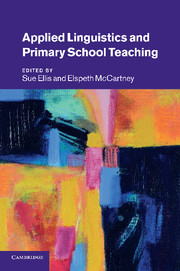Book contents
- Frontmatter
- Contents
- List of figures
- List of tables
- Notes on contributors
- Preface
- Editors' notes and conventions
- Introduction
- Part I Policy and diversity in the twenty-first-century primary school
- Introduction to Part I
- 1 The control of language or the language of control? Primary teachers' knowledge in the context of policy
- 2 Working with children who speak English as an additional language: an Australian perspective on what primary teachers need to know
- 3 Preparing for diversity: the alternatives to ‘linguistic coursework’ for student teachers in the USA
- 4 Supporting children with speech, language and communication needs
- 5 Foreign language teaching in the primary school: meeting the demands
- Part II The range and focus of applied linguistics research
- Part III Empowering teachers and teachers' use of knowledge
- References
- Index
3 - Preparing for diversity: the alternatives to ‘linguistic coursework’ for student teachers in the USA
Published online by Cambridge University Press: 26 April 2011
- Frontmatter
- Contents
- List of figures
- List of tables
- Notes on contributors
- Preface
- Editors' notes and conventions
- Introduction
- Part I Policy and diversity in the twenty-first-century primary school
- Introduction to Part I
- 1 The control of language or the language of control? Primary teachers' knowledge in the context of policy
- 2 Working with children who speak English as an additional language: an Australian perspective on what primary teachers need to know
- 3 Preparing for diversity: the alternatives to ‘linguistic coursework’ for student teachers in the USA
- 4 Supporting children with speech, language and communication needs
- 5 Foreign language teaching in the primary school: meeting the demands
- Part II The range and focus of applied linguistics research
- Part III Empowering teachers and teachers' use of knowledge
- References
- Index
Summary
Introduction
During a one-on-one tutoring session, a pre-service teacher, Sharon, reads aloud a non-fiction children's book about water. The kindergarten child, Elaina, experiences this English text in her second language. On the last page, the book's illustration depicts a body of water, referred to in the text as a ‘lake’. As Elaina reads the pictures, she reacts with certainty to Sharon's misreading of the printed words:
elaina: No. That's a pond.
sharon: Well, it looks like a pond, but that's a lake. Do you know what a lake is?
elaina: No, but I have been to a pond.
Sharon and Elaina's interaction represents the challenge facing all educators, whether they are student teachers, qualified teachers or those working in initial and continuing teacher education contexts: No two children bring identical linguistic resources to their learning and increased linguistic and cultural diversity has become a common reality across all contexts. All educators must learn to build upon the diverse knowledge and experiences that pupils bring to the classroom. This includes the social, cultural and linguistic resources from both in-school and out-of-school literacy practices. The question facing policy makers concerned to find the most efficient way to develop teacher knowledge and the teacher educators who design pre-service courses is: how might student teachers, such as Sharon, best learn to develop the language and literacy resources of children, such as Elaina?
- Type
- Chapter
- Information
- Applied Linguistics and Primary School Teaching , pp. 44 - 52Publisher: Cambridge University PressPrint publication year: 2011
- 7
- Cited by



